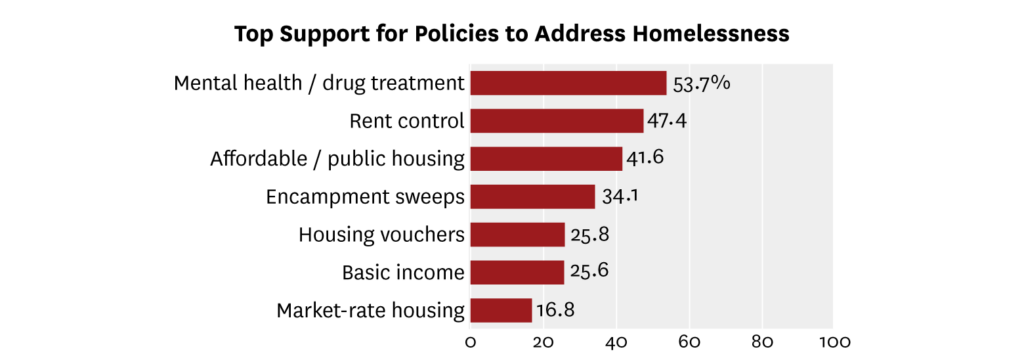In a politically divided election year, Angelenos agree that one issue is pressing: homelessness. Recent findings from our fifth annual LABarometer survey on Livability & Affordability in Los Angeles reveal the impact of homelessness on the county. The survey included questions on homelessness developed in collaboration with the USC Homelessness Policy Research Institute. Here are the top five takeaways:
1. On a daily basis, two-thirds of Angelenos see someone experiencing homelessness. Nearly 1 in 10 have experienced homelessness themselves.
Homelessness is all around. Nearly every Angeleno (93%) considers homelessness a problem in L.A. County and a majority (64%) say homelessness is a problem in their own neighborhood. A similar percent (63%) report seeing a person experiencing homelessness on a daily basis. On a weekly basis, that number rises to 82% of Angelenos. Additionally, nearly 1 in 10 residents have experienced homelessness themselves and 2 in 10 know a friend, family member or coworker who has experienced homelessness.

However, we find important variation in exposure to homelessness by income and race. High-income residents are less likely than low-income residents to say homelessness is a problem in their neighborhood. One of the most striking outcomes is variation by race. Over 20% of Black respondents have been homeless at some point, compared to 9% of whites and 8.5% of Hispanics. Asian residents have the lowest rate of lifetime homelessness. Racial differences in experiences of homelessness remain statistically significant when we control for related factors like income and education.

2. Mental illness and substance abuse are widely perceived as major contributors to homelessness, followed by housing costs.
When asked to rate which factors are major or minor contributors to homelessness, 85% of residents identify mental illness and 84% identify substance abuse as major contributors; 78% identify housing costs as a major contributor. A minority of Angelenos perceive laziness, a preference for the street or racism/discrimination as major contributors to homelessness.

Notably, Angelenos who have experienced homelessness are more likely than those who haven’t to say that housing costs (90% vs 76%) and racism/discrimination (42% vs 29%) are major contributors to homelessness. The perceived contribution of other factors, like mental illness and substance abuse, do not differ significantly between those who have and haven’t experienced homelessness.
3. Most Angelenos support a range of policies to alleviate homelessness, but support dips among homeowners – especially when it comes to implementation in their neighborhoods.
The majority of Angelenos support a wide range of policies to alleviate homelessness. Over 80% of respondents support mental health and drug treatment as well as the construction of affordable housing. High percentages support rent control, encampment sweeps and housing vouchers. Smaller majorities support the construction of market rate-housing and a universal basic income as a means of alleviating homelessness.

Support for these policies does vary along socioeconomic lines. One of the largest determinants of policy support is homeownership. Homeowners are much less likely than renters to support housing-related policies such as affordable housing, vouchers and rent control. Homeowners, on the other hand, are more likely than renters to support encampment sweeps.
The gap in sentiment between homeowners and renters grew particularly striking when we asked respondents if they would support the implementation of certain housing policies on their block. For example, 71% of renters back affordable housing construction in their neighborhood compared to 53% of homeowners.

4. While most residents support varying policies to alleviate homelessness, they lack consensus when it comes to prioritizing those policies.
When we look at the three policy solutions that residents favor most (those who expressed support for more than three policies were asked to identify their top three), we find that a slight majority of respondents (54%) selected mental health/drug treatment. Yet, most policy solutions are not prioritized by a clear majority, a sign that Angelenos lack consensus when it comes to policy priorities. In our survey, the policy solutions that receive the highest level of prioritization are mental health/drug treatment (54%), rent control (47%) and affordable/public housing (42%).

5. Nearly 1 in 4 Angelenos have experienced some form of housing instability in adulthood.
To better understand adulthood exposure to housing instability in L.A., we asked respondents if they had spent a month or more in an unstable housing situation, such as couch surfing or living in a hotel, car, shelter or on the street since they turned 18. According to our results, 23% of residents have experienced some form of housing instability as adults. The most common experience is couch surfing (17%) – i.e. staying with a friend or family member in their home – followed by a hotel or motel (8%). Five percent of residents have lived in a vehicle or outside (in a tent or public place) as adults and 9% of residents have lived in two or more of the temporary housing situations listed below.

We also asked respondents if they had experienced or been threatened with involuntary displacement as adults. According to our data, 6% of Angelenos have been told at some point to leave by a landlord or lender and 3% have been evicted from their home. Overall, 12% of Angelenos have experienced or been threatened with involuntary displacement as adults.
About the survey
The LABarometer Livability & Affordability survey tracks neighborhood livability and affordability stress in Los Angeles County, guided by the principle that a livable neighborhood is one in which residents feel happy, healthy, safe, socially connected, and have access to affordable goods, services, and amenities. Wave 5 of the Livability & Affordability survey was fielded from June 24, 2024 – October 15, 2024 and a total of 1,507 Los Angeles County residents participated. Participants were recruited from the LABarometer Panel and the survey completion rate was 75%.
Learn more
To learn more about livability and affordability issues in L.A., including residents’ attitudes towards and experiences of homelessness, check out our latest press release, topline, or visit our website.
Sign up for Schaeffer Center news

You must be logged in to post a comment.